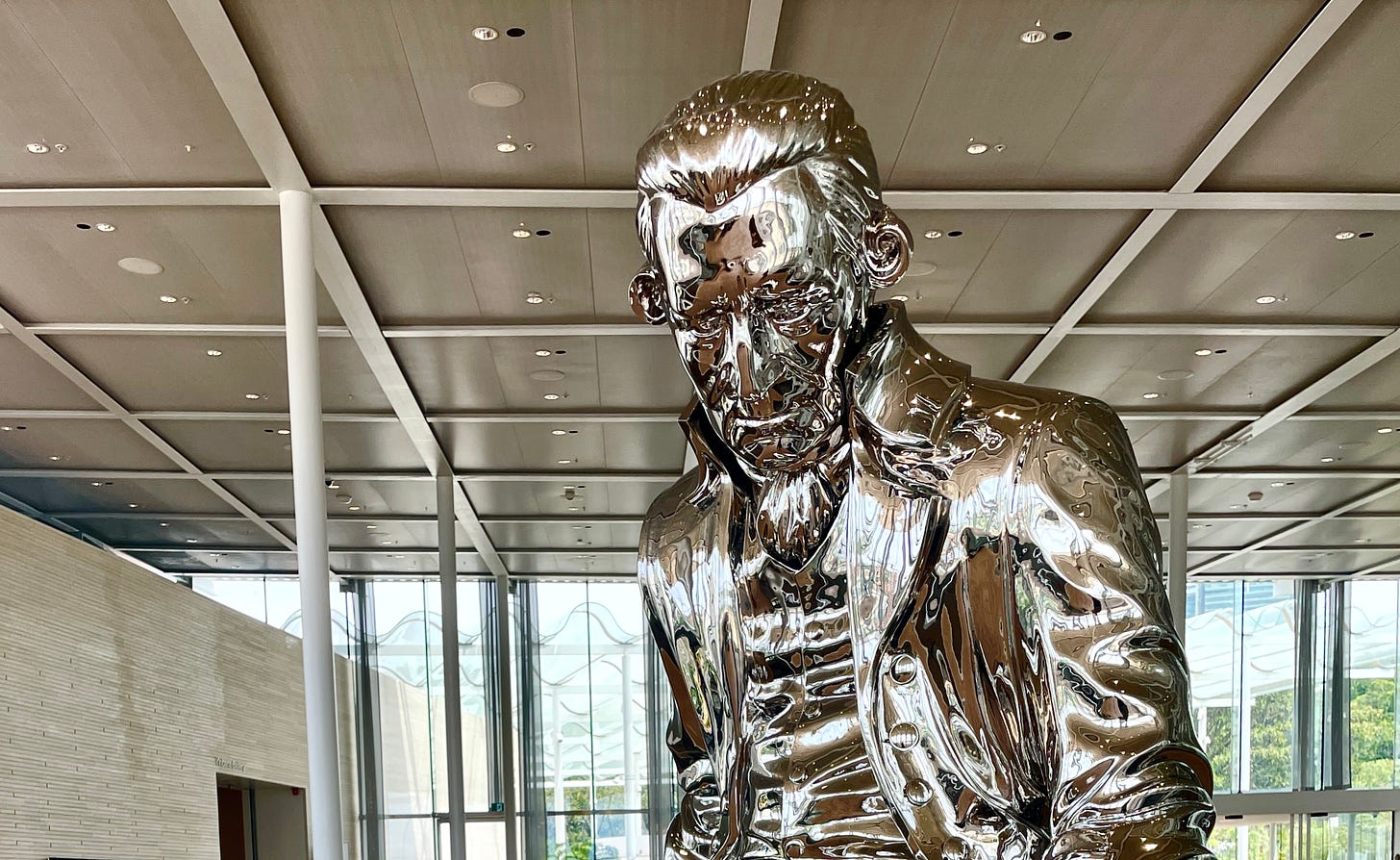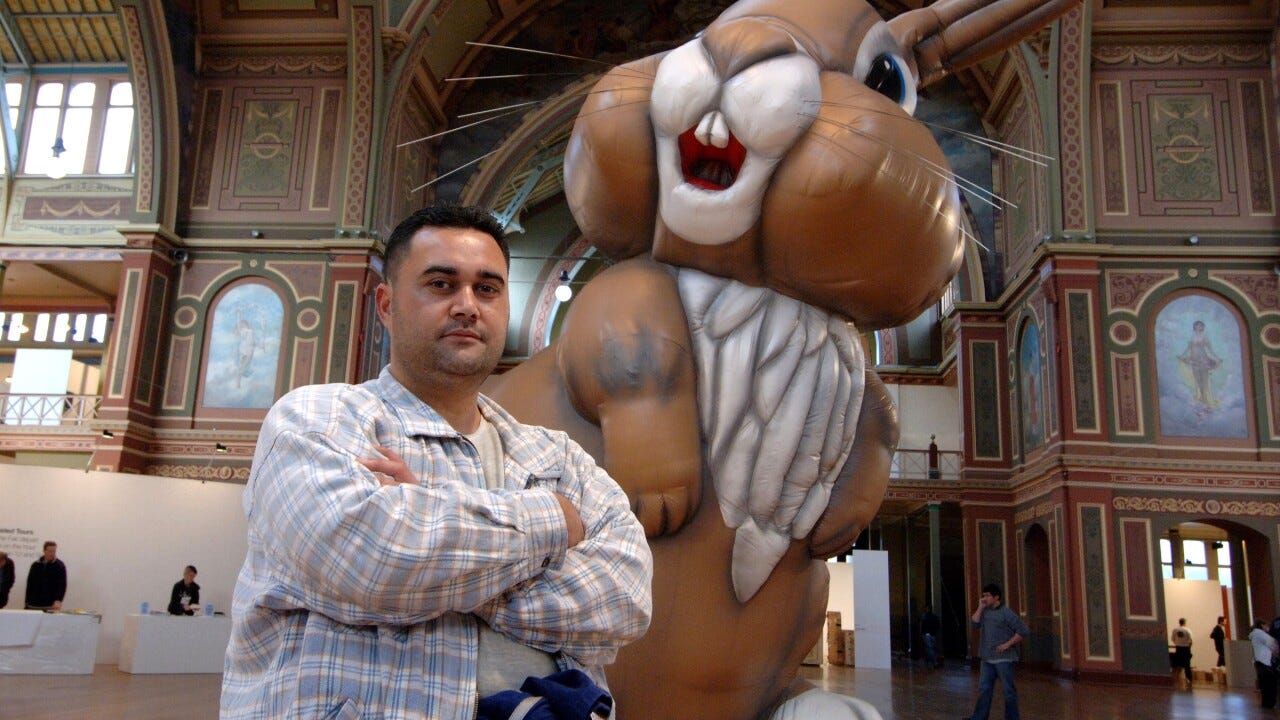What This Statue Teaches Us About Art, Colonialism, and Ourselves
Michael Parekōwhai's 'The English Channel' takes the metaphorical role of the viewer literally - providing a singular master class for all storytellers
Captain James Cook was a British cartographer, explorer, and naval officer who “discovered” Australia in 1770. His arrival on the eastern coast of what is now identified on most maps as New South Wales portended doom for the vast continent’s indigenous peoples, as it was followed by two centuries of conquest and genocidal policies and then another fifty years of failed, often still very racist policies allegedly intended to correct the horrific offense.
In the 18th Century, Cook’s countrymen would’ve called him a hero. Today, he is primarily viewed as a symbol of British colonialism – a global campaign of conquest and terror that directly and indirectly killed tens of millions and laid such waste to cultures that many of them have yet to fully recover. Now, you would think that would also mean he’s primarily viewed as a villain these days, but, well, that is not the case. This experiential and temporal subjectivity is explored in an artwork I’ve recently encountered, which I think has a lot to say about the role of the viewer in our creative endeavors.
The artwork in question is called The English Channel (2015) and is by New Zealand artist Michael Parekōwhai, whom I’ll tell you more about in a moment. Here’s a recent video I took of it after it was moved from its temporary home in the Captain Cook Wing of the Naala Nura building of Art Gallery of NSW’s campus to its permanent home in the brand-spanking-new Naala Nadu building next door. I should note, it’s no longer called the Captain Cook Wing, at least not officially, but that is how the wing was called when it opened in 1972 – three years before the official end of the White Australia Policy (or, white only policy).
I know this is a lot of preamble, but I think it’s also worth reading how Art Gallery NSW describes The English Channel1 and a few words about the artist:
Larger than life and created from highly polished steel, it sits in the Australian galleries, in front of the Gallery’s ground floor windows with their view of Sydney Harbour. The figure, with flowing topcoat and ponytail, is the British navigator Captain James Cook.
But this is not Cook as he is seen in the many historical monuments that bear his name – nor in the famous 1776 portrait painting by Nathaniel Dance which is one inspiration for this sculpture. Resting without his feet touching ground on a sculptor’s working table, this Cook seems to be reflecting on his legacy in the contemporary world. At the same time, his dazzling surface collects the reflection of everything around it – including the harbour past which Cook sailed in 1770 and the visitors in the room. Despite the sculpture’s considerable height and weight, this mirror-like surface lends it a slippery and elusive presence; the sculpture changes as the light changes and as viewers move around the room. The result is a monument of a very contemporary kind – not a full stop marking the end of a story but a question mark inviting reflection.
As for the artist behind this statue, Michael Parekōwhai (b. 1968) is a New Zealand artist of Maori (Ngati Whakarongo) and Pakeha (European) descent. I’m not nearly as familiar with his work at this point as I want to be, but I’m sold. I will never pass up the opportunity to see any of it again.
Okay, at this point you’re probably wondering why I’m telling you so much about this specific piece of contemporary art by an artist I’d wager most of you don’t know. Aside from the fact that I take great satisfaction in being able to discuss Australian/New Zealand artists here, I believe that great art is a conversation between the artist and the viewer, I believe that art is a mirror that reflects who we are for better or worse, I believe that such conversations and reflections can and very often do evolve with the passage of time to take on new meanings, and I believe that Michael Parekōwhai’s The English Channel is a singular master class in all these things.
Let’s break down what I’m saying here…
Great art is a conversation between the artist and the viewer.
I’m going to come back to a quote from Ansel Adams I often share here at 5AM StoryTalk: "There are always two people in every picture: the photographer and the viewer."
This is true for any creative medium, not just photography. The viewer – the audience – has an identity of their own, their own sense of the world, their own prejudices, and so on.
Another way to put this is, the art you create isn’t just being experienced by amorphous human shapes with monolithic life experiences.
Art is a mirror that reflects who we are for better or worse.
This is true of art of any kind, regardless of how “important”/serious or “commercial”/shit or whatever you think it is. It’s all a multifaceted expression of our culture.
For example, you might say superhero films are mindless dreck. Regardless if this is true — and I don’t believe it is — their proliferation, their generally neutered politics and bifurcated view of “good and evil”, their general simplification of incredibly complicated subjects reveal things about where our cultures are today and quite possibly the rise of fascism across the West (at least if you agree with Alan Moore).
The conversations and reflections provided by art can and very often do evolve with the passage of time to take on new meanings.
As the world turns, our cultures change and, as they do, so does how we view past pieces of art. What was once celebrated becomes problematic or even vilified, helping us to better understand where we came from. But likewise, artworks that were intended to represent something positive by artists might be adopted by other negative elements within a culture and assigned new meaning.
An example of this would be the Wachowskis’ The Matrix (1999), which was a created as a coded trans allegory. Later, Far Right types – fixating on the Red/Blue pill of it –decided the film series was instead an allegory for waking up from the fantasy that white cishet men aren’t the center of the universe. If political attitudes continue to shift to the Right, this obvious misinterpretation of the artists’ stated intent could become the dominant explanation of the film series. (You can read more about this here.)
The English Channel takes each of my three stated positions about art and gives them literal – not metaphorical – form. Let’s take a look at it through those “rules” I provided.
Great art is a conversation between the artist and the viewer.
Michael Parekōwhai’s use of polished steel here means it’s impossible to get close to his statue – to the subject of Capt. Cook – without seeing yourself in it. You’re not just an abstract viewer as Ansel Adams was getting at. You’re a literal part of the conversation that the artist and his art is having with you.
Art is a mirror that reflects who we are for better or worse.
With The English Channel, Parekōwhai knows Cook is a controversial figure who provokes a debate that many white people find confronting and deeply uncomfortable. Again, he makes literal what is typically an abstract or metaphorical experience by including you in the artwork itself. Everything you bring to it – your subjective life experience – helps to give form to Cook himself and, hence, the subject of British colonialism.
In other words, who you are defines the man/subject — which can also serve as an indictment of you, your privilege, and/or your position as a result of what Cook set in motion.
The conversations and reflections provided by art can and very often do evolve with the passage of time to take on new meanings.
The placement of The English Channel in the Art Gallery NSW’s Naala Nadu building, specifically in front of windows that face Sydney Harbor, mean that the statue will constantly change with the city outside. Parekōwhai’s polished steel not only reflects who you are, but what Australia is today.
In this, there’s an extra rub. What’s outside those windows and, thus, part of Cook’s legacy is a “colonizers’ city” imposed on stolen land. For Sydney is on Gadigal Country, land that was inhabited by First Nations people for tens of thousands of years – in fact, the world’s oldest living civilization. “Always was, always will be Aboriginal Land” as Australian residents are regularly reminded, in case any of them forget.
At this point, it might make sense for you to expect some kind of clear-cut lesson as a take-away, some kind of easily digestible rule about art you can action yourself as you work. But as I’ve said many times before at this newsletter, my “lessons” are more like examples most of the time and rules tend be as subjective as art (so why fixate on them). Instead, I want you to consider what Michael Parekōwhai set out to accomplish here with The English Channel. Ask yourself what challenges he faced discussing this subject, such as how to both draw in and provoke viewers like you. Ask yourself about the unique role of the viewer in the piece’s emotional efficacy. Ask yourself how you felt when you watched the video of it. These are all relevant, necessary, even exciting questions when interrogating your own work, how others will experience it, and storytelling forms and their possibilities in general.
If this article added anything to your life but you’re not up for a paid subscription, consider buying me a “coffee” so I can keep as much of this newsletter free as possible for the dreamers who couldn’t afford it otherwise.
If you enjoyed this particular article, these other three might also prove of interest to you:
https://www.artgallery.nsw.gov.au/artsets/6fd57c










There is so much here to digest and I suspect I’ll be thinking about this all day. Sometimes it’s good to be made uncomfortable by art. And absolutely, art’s meaning changes over time. I wish the US understood this. Maybe someday I’ll get over my fear of flying and get to Australia and New Zealand. The history there….. sigh
This was an excellent article, thank you, Cole.
I also live in a Cook-“discovered”region (Canada’s west coast), and challenging art is the best way to carry on the conversation about colonialism. That is an amazing sculpture.